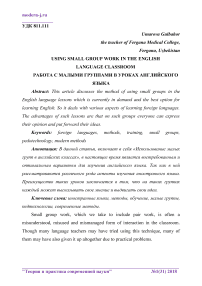Using small group work in the English language classroom
Автор: Umarova G.
Журнал: Теория и практика современной науки @modern-j
Рубрика: Основной раздел
Статья в выпуске: 1 (31), 2018 года.
Бесплатный доступ
This article discusses the method of using small groups in the English language lessons which is currently in demand and the best option for learning English. So it deals with various aspects of learning foreign languages. The advantages of such lessons are that on such groups everyone can express their opinion and put forward their ideas.
Foreign languages, methods, training, small groups, pedotechnology, modern methods
Короткий адрес: https://sciup.org/140289440
IDR: 140289440
Текст научной статьи Using small group work in the English language classroom
Small group work, which we take to include pair work, is often a misunderstood, misused and mismanaged form of interaction in the classroom. Though many language teachers may have tried using this technique, many of them may have also given it up altogether due to practical problems.
On the other hand, there some teachers who do use small group work without really knowing why, except that it makes them appear up-to -date with new trends in English Language Teaching.
This article will discuss the use of small group work as a means of maximizing learning in the English Language Classroom. It can be used with the majority of areas and skills inv olved in English Teaching. More importantly, small group work is an ideal way of providing the freedom students need in learning and of helping students help themselves to learn. To be able to maximize the use of small group work, it is important to unders tand the “why” of small group work. Why do we use small group work in particular activities in our class? When we advocate the use of small group work, we do not mean that we are asking for anyone to do away with the whole class work. It is important to un derstand the advantages and disadvantages of using whole class activities.
Advantages
-
1. Time saving
-
2. Achieves immediate results
-
3. Easier to manage class
-
4. Less effort in preparation
-
5. Expected by students
Disadvantages
-
1. Less student participation
-
2. A few students dominate discussion
-
3. “Slow” students are neglected
-
4. Teacher dominates
-
5. Less freedom for learning.
As we can see from the list, there are many benefits in using whole class work. In such type of interaction, the teacher can make sure that everybody in class gets the same information he or she wants to get across. There are certain activities in which whole class work is indispensable.
Whole control is the main strength of this mode of classroom interacti on; it is also its main limitation. It limits students‘ freedom and creativity.
What we need, therefore, is a right choice of form of classroom set-up or organization. When do we use whole class interaction or a small group work?
Teachers should first de cide on the appropriate kind of classroom interaction or on the appropriate combination of these kinds of the interaction, depending on their main activity objective. The key here is the main objective of the phase of the language lesson. What is our goal? Accuracy or fluency?
Accuracy activities are meant to make sure that students get enough practice in a particular grammar point, vocabulary or pronunciation. The objective is to get students to practice a certain language point accurately. This is done in the “practice” stage of a lesson. Fluency activities, on the other hand, are meant to give students opportunity to use the language points they have learned. The objective of these activities is for students to use the language freely, even if they make mistakes. This is used in the “production” stage of a lesson. In actual teaching situations, we will need to provide opportunities for both accuracy and fluency work. It is teachers‘ responsibility to determine the appropriate class organization. (Whole class, pair work and group work) to be able to achieve the goal of the lesson phase (accuracy or fluency) in such a way that students will be cognitively challenged and affectively involved.
After choosing small group work as an appropriate form of interacti on for a certain activity, the next big question that the teacher faces is: How do I deal with the logistics of setting it up? The following guide lines might be helpful in considering answers to this question (Nolasco and Arthur, 1995):
-
1. Stage instructions for the learners: Appropriate instructions play a vital role in setting up the learners to accomplish the given task.
-
2. Demonstrate the task when necessary: The teacher can demonstrate part of the instructions, to help the students to understand.
-
3. Speak clearly: Our audiences are our students, so we must ensure that our voice and pronunciation are clear.
-
4. Put instructions in a logical order: From a cognitive point of view, a teacher can stage the instructions from the learners so that they progress from simple to complex.
-
5. Use simple, direct statements: We want our students to go from point A to B in the simplest way. Use simple language.
There are two important points that we need to stress from the preceding discussion. First, that using small group work is more than just a matter of dividing the class into small groups. Secondly, that although small group work is desirable, it can be a deterrent to learning if not used appropriately.
Список литературы Using small group work in the English language classroom
- Buckley, P. (1982). Is group work fe asible in monolingual class? Practical English Teaching.
- Byrne, D. (1995). Techniques for Classroom Interaction. Harlow Essex. Longman.
- Nolasco R. and Arthur L. (1995). Large classes. Hertfordshire: Phoenix ELT.


